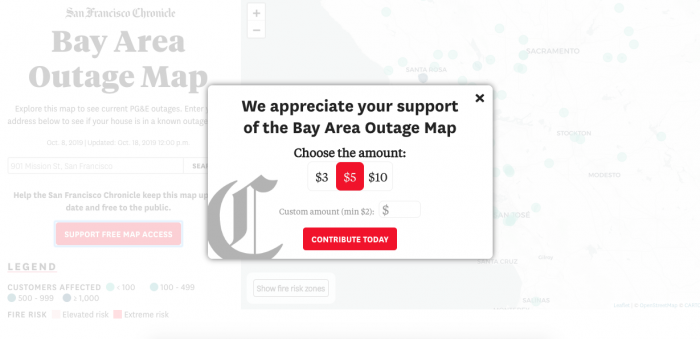
When California’s largest utility company cut power for thousands to avoid wildfires a couple of weeks ago, the San Francisco Chronicle turned to A/B testing — and a little tool called LaterPay.
The Hearst-owned Chronicle, like most other metro newspapers these days, is increasingly oriented toward digital subscriptions, of which it has about 80,000. So when PG&E’s public safety power shutoff loomed, several California news organizations developed maps for readers to track how the days-long outage affected their own communities. (PG&E had one too, but it kept crashing.) But not all of them were publicly accessible.“The outage coverage was one of our highest traffic days ever for both of our sites [the Chronicle and SFGate]. We knew that the outage map was some specific IP we created,” publisher Bill Nagel said. (The Chronicle’s map credits seven people, including three developers and editor-in-chief Audrey Cooper.) “We knew the content had value. What we’re trying to emphasize with our customers is that the content has value — that it’s either subscribe-able or worth paying for.”
The Mercury News in San Jose lifted its paywall for its map; public media outlets didn’t have one in the first place; and The Los Angeles Times kept its map walled. But the Chronicle took a different approach: showing some users an invitation to subscribe and others the ability to pay directly via the micropayments platform LaterPay. “It was a record day for us for subscriptions…and since it was our first experimentation with LaterPay, it was our best day with LaterPay,” Nagel said.
LaterPay, which we’ve written about before, is an attempt to get readers committed to micropayments by postponing their biggest initial hurdle: setting up a payment method. Site visitors can read a few articles, working up a bill, but they won’t be asked to pay until their total hits $5. Here’s how LaterPay describes itself in 2019:You just confirm that you will pay later and you get access to your desired content — without having to register before your purchase and without having to give any payment information. LaterPay remembers all purchases made from your device and bundles them into one invoice. You can shop on any site supporting LaterPay and these purchases will be added on your LaterPay invoice. As soon as you have accrued a total of $5.00 on your invoice, we will ask you to register and settle with one of the supported payment methods. You will not incur any fees — you only pay for what you buy.
The Chronicle has so far only used LaterPay on its outage map, which is a different approach from (maybe less power outage-prone) outlets who have tried it in the past few years. The Boston Globe tested it on three sections of its site for five months, ending in January 2019, according to director of consumer analytics Thomas Brown. “We did not generate much in the way of revenue, but did sell over 10,000 articles,” he told me in January. “However, because an individual did not have to settle their tab until they reached a $5 threshold (an individual article was $0.49), it was not a big revenue driver.”
LaterPay is one of the revenue-driving experiments the Chronicle is working on. “The one thing I would tell you is that given the enthusiastic response we saw from subscription, we’re learning more and more about what is subscribe-able content and how much you serve up to our readers and potential subscribers,” Nagel said.
The LaterPay user option was framed as a more heartwarming experience than the typical “You’re out of free articles!” a paywall might bring. You could still see the map for free, but the brightest button on the page asked you to SUPPORT FREE MAP ACCESS, which took you to the Chronicle’s LaterPay page. It feels like you’re just making a regular donation — but obviously Hearst is a private for-profit company that can’t typically use a “send us a few bucks for a tote bag” kind of positioning.
Nagel said the Chronicle is still reviewing the outage map experiment and may share its findings later on, as it plans for quite possibly the next power outage. PG&E, bankrupt, sanctioned, and blamed for sparking previous disastrous wildfires, has warned that these mass outages may become the “new normal.” State lawmakers and editorial boards have warned that it better not.
But for news consumers, the new normal is that someone has to pay for news, maybe even vitally important information like where to go to charge an electric wheelchair — and it might be you.
“The moment of power outage has passed and we’re in the process of evaluating those results to determine for the next power outage which of the methods, or even a third method, we may try — simply to understand what is going to work best for us from a subscriptions standpoint, from a monetization standpoint,” Nagel said.